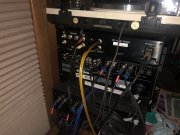- Joined
- Mar 22, 2022
- Messages
- 9
A often understood aspect of audio equipment is the levels that they output. It may come as quite a surprise to find that the majority of equipment we use, sticks strictly to what is called consumer line level, let me rephrase that to note that it is the media we enjoy that contains the level, and with most cases the equipment similarly just meets the same specification.
So what is consumer line level ? , its popular measurement is expressed as fractions of Volts RMS ( root Mean Square ) and its nominal level is 0.316V RMS , it has a peak amplitude to 0.447V RMS and peak to peak amplitude of 0.894V RMS. In the image we see total compliance to these figures. The light blue trace shows the nominal RMS and the peak in dark blue.
So what about balanced professional audio ? It too has similar compliance Nominal is 1.228V RMS , Peak amplitude of 1.736V RMS and Peak to Peak to 3.472V RMS
Whilst some forum members may have recording studios, and equipment sporting balanced output and input, the rest of us are likely to immensely enjoy consumer line level.
So what is consumer line level ? , its popular measurement is expressed as fractions of Volts RMS ( root Mean Square ) and its nominal level is 0.316V RMS , it has a peak amplitude to 0.447V RMS and peak to peak amplitude of 0.894V RMS. In the image we see total compliance to these figures. The light blue trace shows the nominal RMS and the peak in dark blue.
So what about balanced professional audio ? It too has similar compliance Nominal is 1.228V RMS , Peak amplitude of 1.736V RMS and Peak to Peak to 3.472V RMS
Whilst some forum members may have recording studios, and equipment sporting balanced output and input, the rest of us are likely to immensely enjoy consumer line level.
Attachments
-
89.3 KB Views: 10


